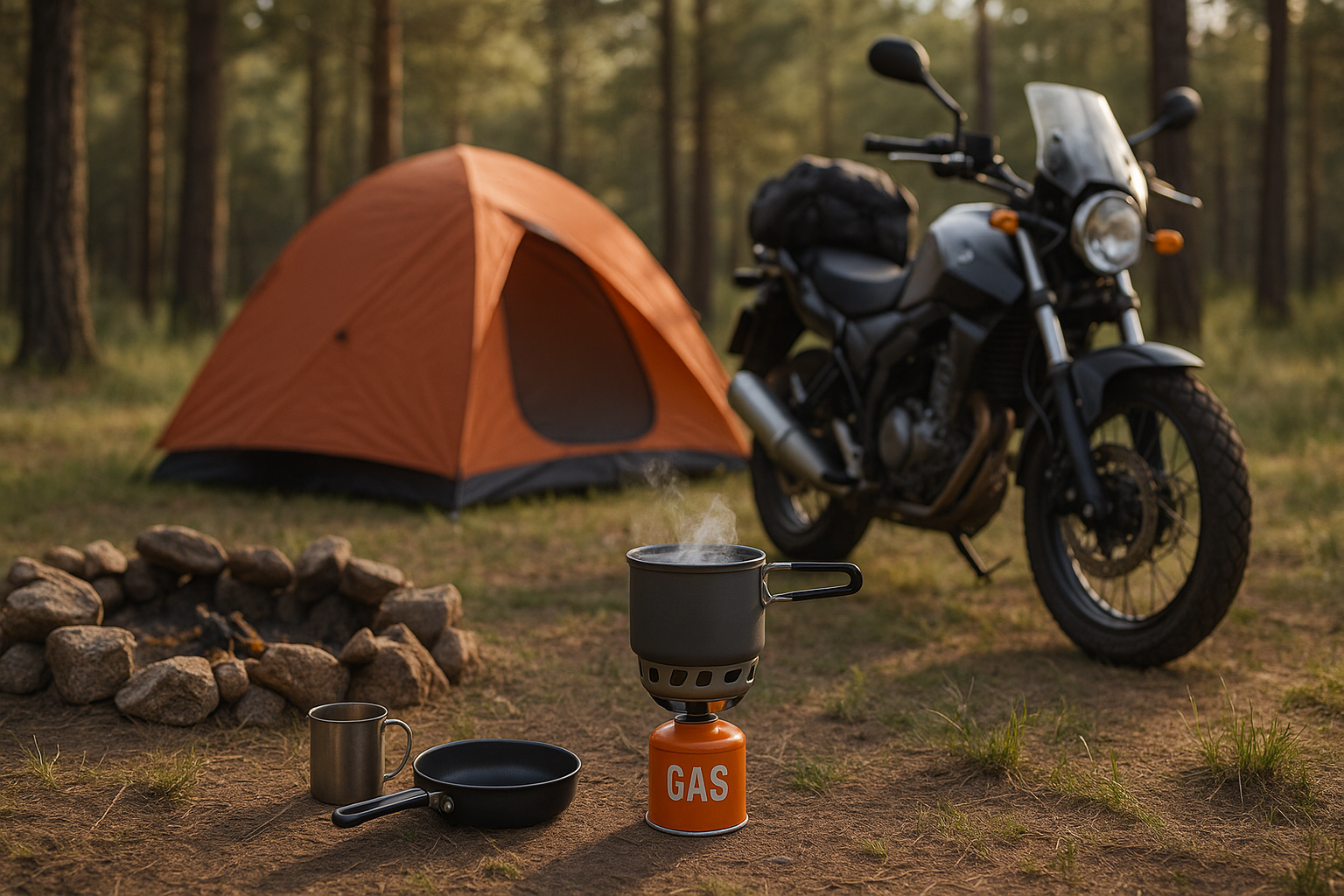You’re deep in the backcountry, the temperature’s dropping, and your stomach’s rumbling. But there’s a sign at the trailhead: No open flames allowed. Forget about a roaring campfire or even a simple twig stove. For motorcycle campers who love remote trails but need a hot meal, this scenario isn’t just frustrating—it’s a challenge that demands ingenuity. This guide unlocks unconventional, packable cooking systems you can use when fires are off-limits, keeping you fueled and safe, no matter the restrictions.
The Power of Catalytic Heaters for Cooking
When flames are banned, catalytic heaters with cooking tops become invaluable:
- How they work: These systems use chemical reactions (like platinum catalysis) to generate steady, flameless heat.
- Compact models: Look for portable catalytic pads or panels designed to sit beneath a pot or pan.
- Safety tip: Always ensure adequate ventilation, especially in confined areas like tents or bivy setups.
Pro Tip: Catalytic systems work best with flat-bottomed pans for even heat distribution.
Flameless Ration Heaters: Field-Tested for Military & Civilian Use
Flameless ration heaters (FRHs), originally designed for military rations, can be a lifeline:
- Compact and self-contained, they generate heat through an exothermic reaction (usually magnesium-based) when water is added.
- Use with MREs or sealed food pouches—just insert the pouch and add water.
- Portable and discreet: FRHs are low-profile and emit minimal light and scent, making them ideal for stealth camping.
Solar Reflector Cooking: Harness the Sun
When the sun’s up but fires are forbidden, why not use its power?
- Foldable solar cookers (like parabolic or panel reflectors) can heat water or cook meals over a few hours.
- Ultralight models collapse into a flat panel—easy to stow in motorcycle panniers.
- Best for hot, clear conditions, this technique is fuel-free and silent.
Pro Tip: Pre-soak grains or legumes during the ride to shorten cook times once sunlight is available.
Thermos Cooking: Slow Heat, Zero Flame
Imagine setting up camp with a hot meal ready—no fire, no stove.
- Method: Bring water to a boil before you leave (from a rest stop with a gas station, for example) and store it in a high-quality thermos.
- Cook by soaking: Add ingredients like rolled oats, couscous, or freeze-dried meals to the thermos. The retained heat cooks them slowly.
- Bonus: Works for both hot and cold soaking, depending on the ingredients and your timing.
Chemical Hand Warmers: MacGyvered Meal Warmers
When options are limited, chemical hand warmers can double as low-heat cookers.
- Pack multiple warmers around a tightly sealed food container (like a metal cup or sealed plastic tub).
- Use insulation (extra clothing or a hat) to trap the heat and increase efficiency.
- This method works best for warming pre-cooked items or slow-thawing frozen foods.
Electric Heating Pads or USB-Powered Cookers
Some campers swear by minimalist electric cooking setups:
- USB-powered cup warmers or 12V heating pads can heat small portions of food or keep liquids warm.
- Draw power from a portable battery pack, solar charger, or your motorcycle’s USB port.
- Limitations: These methods are slow and best suited for keeping items warm or preparing instant meals.
Pro Tip: Pair with insulated containers to conserve heat and reduce power drain.
Chemical Cooking Pouches for Solo Meals
- Single-use chemical cooking bags, similar to FRHs, are designed for hikers and campers.
- Activation is simple: Add water to the bag, and the internal heating element warms the sealed food.
- Ideal for individual portions—compact and lightweight for solo motorcycle camping.
Insulated Cooking Pouches for Passive Heating
- DIY tip: Make an insulated pouch from a space blanket and fabric scraps.
- Place a hot container of food inside and let it sit for 20-30 minutes. The insulation traps heat and continues cooking or warming the food.
- Great for soups, stews, or precooked meals that just need to be reheated.
Dry Baking Using Heat Retention
If you’re craving bread or a baked treat in camp:
- Preheat a sealed metal container (like a mess tin) with hot water or heated items (FRHs or chemical packs).
- Fill with pre-mixed dough (think bannock or flatbread) and seal it tightly.
- Retain heat using insulation, and after a couple of hours, you’ll have a rudimentary baked item.
Field-Tested Gear for Fireless Cooking
Consider adding these items to your motorcycle camping kit:
- Jetboil Joule or Genesis Basecamp System: While these are gas stoves, using them at a rest stop (when not prohibited) allows you to carry hot water for thermos cooking or hot soaking.
- Sunflair Portable Solar Oven: Lightweight, collapsible, and capable of cooking stews, grains, and even cookies.
- Hydro Flask or Stanley Classic Thermos: Essential for heat retention and thermos cooking.
Packing Tips for Fire-Free Cooking Kits
- Prioritize multi-use containers—a sturdy metal mug doubles as a cooking pot.
- Use nesting kits to minimize bulk and weight.
- Seal all items in waterproof bags to prevent leaks, especially chemical or solar gear.
- Include a mini hygiene kit for cleaning without a campfire’s sterilizing flames.
Conclusion: Adapt, Improvise, and Eat Well
When the open-flame option disappears, motorcycle campers don’t have to resign themselves to cold rations or sketchy snacks. Whether you harness the sun, chemical reactions, or cleverly repurpose gear, these portable, fire-free systems deliver reliable, satisfying meals in any environment. Keep your ride light, your meals hot, and your adventures rolling—no fire required.

